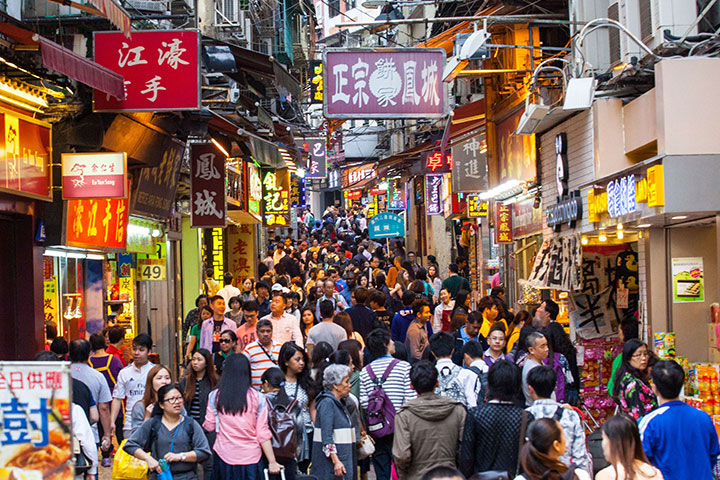IFT Releases Macau Carrying Capacity Report

Study claims Macau visitor reception capacity may have reached saturation in 2014
The Institute for Tourism Studies (IFT) recently released the 'Study on Tourism Carrying Capacity of Macau 2013-2014' with the objective of determining the optimum number of visitors that Macau can comfortably receive per day. The study concluded that the optimum number of visitors per day is between 89,374 and 92,325 entries, and 32 to 33 million visitors a year, and that Macau may have already reached saturation point.
First commissioned by the Secretariat for Social Affairs and Culture in 2003, the IFT has again conducted a Tourism Carrying Capacity (TCC) study for 2013-2014. Several various methods for assessing a tourism destination's optimal capacity to receive visitors are employed by researchers in the industry, and in Macau's case IFT adopts two approaches to determine the optimum number of visitors. The first approach is based on the concept of what is termed Social Carrying Capacity (SCC), which uses subjective measures perceived and experienced by residents and visitors. The second approach assesses changes in the Physical Carrying Capacity (PCC) of key tourism infrastructure elements and physical facilities.
The SCC approach estimates optimum carrying capacity based on Macau residents' satisfaction with factors affecting their quality of life and visitors' satisfaction with the quality of their visiting experience. These subjective factors include the perceived level of crowdedness, satisfaction with the quality of the environment, satisfaction with transportation services, service quality and waiting time in food and beverage establishments as well as retail outlets, and satisfaction with tourist attractions as well as recreational activities, (e.g.) satisfaction with border immigration clearance. Visitors are also tasked on providing their satisfaction level with hotel service performance and availability of hotel rooms. Multiple regression modelling of the relationship between these factors and daily visitor numbers helps determine an estimated optimum capacity.
Data for the SCC approach is collected via an extensive field survey conducted throughout the year, with results for 2013, for example, based on data collected from 6,005 respondents (of which 2,987 were residents and 3,018 visitors). For 2014, survey data was obtained from 6,007 respondents (2,991 residents and 3,016 visitors).
The Physical Carrying Capacity approach evaluates the physical and service carrying capacities of eight major tourism-related infrastructure elements and services. These comprise hotel accommodation, restaurant and dining facilities, public buses, taxis, ferries, border immigration clearance, major non-paid visitor attractions, and inbound tour operations. IFT collects data directly from organisations that manage, operate or utilize the above facilities to gauge their physical service capacity for service residents and visitors.
Compared to previous years, Macau's tourism carrying capacity (based on the SCC approach) has increased in a stable manner but reached a highpoint in 2013, suggesting that Macau's capacity to absorb visitors may have reached saturation in 2014. Although critical measures were taken in 2014 to augment capacity in several areas such as extending the opening time of the border entry points, releasing new taxi licences, and implementing crowd control measures during peak visitation periods such as Chinese New Year 'Golden Week', the effects of these improvements were not proportional enough to the continued increase in the number of visitors especially on some peak days.
IFT says it will endeavour to explore other complementary methods to assess Macau's tourism carrying capacity in order to provide accurate and reliable information, taking into account as many perspectives as possible to support better policy formulation and enhance Macau's tourism development.
The study emphasizes that it is important that physical capacity growth of key infrastructure and facilities is co-ordinated. Additional room capacity provided by recent (and upcoming) new hotel properties, for example, will not prove efficient if there is no corresponding increase or enhancement in other areas such as public transport and improvements in service quality.
It is also highly recommended that measures be taken to moderate and balance the growth in visitor numbers so that it is managed in a stable method, avoiding any rapid surge or decrease in addition to greater selectivity in target source markets to achieve diversity and quality.
The continued expansion of service infrastructure and facilities as well as availability and diversity of attractions is important, as is encouraging variations and co-ordination of opening hours or periods of selected attractions as well as the scheduling of events in order to distribute demand more evenly throughout the year and throughout each day.
The study also recommends defining certain zones for long-term development, clearly delineating areas where tourism development can be more concentrated, whilst being segregated from residential areas. In addition, it is recommended that in order to reduce congestion at key areas of the city, facilities or zones be developed to cater to the needs of frequent cross-border shoppers, many of whom visit Macau for one day only.
To learn more about the findings of the annual study of Macau's Tourism Carrying Capacity, 2013 and 2014, please visit:
www.ift.edu.mo/EN/press/Home/Index/242#!page=press_release_detail.aspx?language=en&news_id=367